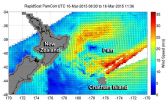(Press-News.org) AUSTIN, Texas - A new method of testing the most common cause of life-threatening infection in people with cystic fibrosis could improve efforts to study and combat the illness.
The bacterium Pseudomonas aeruginosa is a leading contributor to hospitalizations, serious illness and early death for people with cystic fibrosis (CF). Scientists at The University of Texas at Austin have found a way to re-create conditions specific to the environment in which the bacterium spreads in the lungs of a person with CF, allowing them to identify several genes that appear to be necessary for its survival.
A description of the method and findings appear in this week's early edition of the journal Proceedings of the National Academy of Sciences.
In cystic fibrosis, a serious genetic disease that causes recurring lung infections, bacteria colonize a patient's lungs, usually beginning in childhood, leading to difficulty breathing. One of the most dangerous of these bacteria is P. aeruginosa, which, within the unique mucus that forms in the lungs of a person with cystic fibrosis, develops into large, antibiotic-resistant colonies.
Although scientists first mapped the genetic structure of P. aeruginosa 15 years ago, efforts to pinpoint how it behaves during an infection and which genes would need to be turned off to stop its spread have been hampered in part by the difficulty of mimicking the unique conditions of a cystic fibrosis patient's lungs. Experiments that model the bacteria in animal cells, for example, have shown that P. aeruginosa behaves and grows in certain ways only when it is in the infected lungs of a person with CF.
Marvin Whiteley, a professor of molecular biosciences, and his research team at The University of Texas at Austin explain in the paper how they applied new technology to bacteria thriving in actual samples of the mucus from CF lungs to model the behavior of the bacterium in that environment. The team was then able to test tens of thousands of mutations of two strains of P. aeruginosa, which helped them identify key ways the pathogen behaves during an infection and the genes that might be essential for reproduction.
"We've developed something other labs can replicate," said Whiteley, who has used this method of studying the bacterium for over five years. "It allows researchers to do relevant experiments in a context that really matters."
Scientists at other institutions studying the bacterium and its effect on people with CF said the research was important and indicated others will follow the lead of Whiteley's lab. The new model allows researchers to run large-scale experiments in conditions that are much more like the actual places where the bacteria colonize, without requiring researchers to collect countless specimens of actual mucus, called sputum, from humans.
"For the past decade, we have understood that Pseudomonas is arguably the major colonizing infection for people with cystic fibrosis. For a long time we have studied Pseudomonas the way we study other pathogens," said John LiPuma, M.D., a professor of pediatrics and epidemiology at the University of Michigan. "But the cystic fibrosis lung is extraordinarily complex. In the research community, we've got to develop systems biology approaches, such as this one, that take a more sophisticated approach to get us where we need to be."
Others note that the ability to re-create conditions closer to the sputum in the lung of a CF patient will lead to better understanding of how different strains of the bacterium behave. It will also allow for easier identification of genes that contribute to the bacteria's spread from patient to patient, and more meaningful scientific experiments to understand the bug's resistance to antibiotics or identify new antimicrobial compounds that target specific genes necessary for maintaining these persistent infections.
"Most studies grow bacteria in test tubes in a rich growth medium they never see in the real world. It's rather like studying lion behavior in a zoo rather than in its natural habitat," said Steve Diggle, an associate professor of life sciences at the University of Nottingham. "What Marvin has done is to try and re-create the sputum that Pseudomonas grows in so we can see what genes are important for bacterial fitness in this environment."
INFORMATION:
In addition to Whiteley, authors of the paper are Keith Turner, Aimee Wessel, Gregory Palmer and Justine Murray. Research support came in part from the Cystic Fibrosis Foundation.
The New Zealand Meteorological Service issued a Storm Warning for the Chatham Islands today as NASA's RapidScat instrument found that winds in one quadrant of Ex-Tropical Cyclone Pam is still generating tropical-storm-force winds east of its center.
The International Space Station's RapidScat instrument captured data on Ex-Tropical Cyclone Pam's winds on March 16 from 08:30 to 11:36 UTC. RapidScat revealed sustained winds over 30 meters per second (108 kph/67 mph) were still occurring southeast of the center.
The forecast calls for southwesterly winds to 50 knots (57 ...
INDIANAPOLIS - An Indiana University cancer researcher and her colleagues have identified genetic markers that may help determine who benefits from regular use of aspirin and other nonsteroidal anti-inflammatory drugs for lowering one's risk of developing colorectal cancer.
Previous studies have shown that regular use of aspirin and NSAIDs lower one's risk of colorectal cancer, but their use is not recommended as a way to prevent the disease because of uncertainty about the risks and benefits. Thus, the researchers set out to examine the interrelationship between genetic ...
New research published with the support of the FP7 large-scale bioinformatics project Building the European Biodiversity Observation Network (EU BON) and the Alien Challenge COST action reveals the importance of open data in the study and control of invasive alien species. The study was published online in open access in the journal Management of Biological Invasions.
Invasive alien species cause a wide variety of problems, including issues related to conservation; to human and animal health; to agriculture and to fisheries management. But how can science be useful to ...
Cramping abdominal pains, diarrhea, bloody stools--these are common symptoms of chronic inflammatory bowel disease. Every year, up to 1470 children and adolescents in Germany develop the disease. But chronic inflammatory bowel disease is mostly diagnosed too late in these patients, as Stephan Buderus, Dietmar Scholz, and colleagues show in an original article in the current issue of Deutsches Ärzteblatt International (Dtsch Arztebl Int 2015; 112: 121-7). The average delay between initial symptoms and diagnosis is four to six months. In most cases, the inflammation ...
DETROIT - New animal studies at Henry Ford Hospital found that sildenafil, a drug commonly used to treat erectile dysfunction, may be effective in relieving painful and potentially life-threatening nerve damage in men with long-term diabetes.
The research targeted diabetic peripheral neuropathy, the most common complication of diabetes, affecting as many as 70 percent of patients.
The study was recently published online in PLOS ONE.
Lei Wang, M.D., the Henry Ford neuroscientist who led the research, said that although numerous drugs have been shown to be effective in ...
CLEVELAND, Ohio (March 17, 2015)--Hormones may not protect women from heart disease or stroke after menopause, but when combined with cholesterol-lowering statin drugs, they may help protect women from these killers, shows a population study from Sweden to be published in the April issue of Menopause, the journal of The North American Menopause Society (NAMS). During the study, women who took both hormones and statins had a significantly lower risk of dying of any cause and a moderately lower risk of dying of cardiovascular disease.
Using health information from national ...
CLEMSON, S.C. -- Placing less reliance on monitoring software and modifying new media training to align with student-athletes' habits and input will promote more positive and responsible usage of social networks.
This is the key finding by researchers from Clemson University, Baylor University and the University of Florida and published in the International Journal of Sport Communication.
The study explored college athletes' social media use and their experiences with and attitudes about a rising trend in college athletics: social media education.
Given the media ...
This news release is available in French. Researchers at the Montreal Neurological Institute and Hospital -The Neuro, at McGill University and the MUHC, are working to develop a much needed tool for helping diagnose concussions or mild traumatic brain injuries suffered by thousands of young Canadians ---hockey and football players among them. Post-concussion symptoms can include physical ailments, emotional disturbances and sleep disruption. Objective methods for predicting how severely mild brain trauma can affect a young person's brain are sorely needed. The potential ...
For Arctic marine mammals, the future is especially uncertain. Loss of sea ice and warming temperatures are shifting already fragile Northern ecosystems.
The precarious state of those mammals is underscored in a multinational study led by a University of Washington scientist, published this week in Conservation Biology, assessing the status of all circumpolar species and subpopulations of Arctic marine mammals, including seals, whales and polar bears. The authors outline the current state of knowledge and their recommendations for the conservation of these animals over ...
The prices of leading cancer drugs have risen at rates far outstripping inflation over the last two decades, according to a new study co-authored by an MIT economist -- but the exact reasons for the cost increases are unclear.
Since 1995, a group of 58 leading cancer drugs has increased in price by 10 percent annually, even when adjusted for inflation and incremental health benefits, the study finds. More specifically, in 1995, cancer drugs in this group cost about $54,100 for each year of life they were estimated to add; by 2013, such drugs cost about $207,000 per each ...


